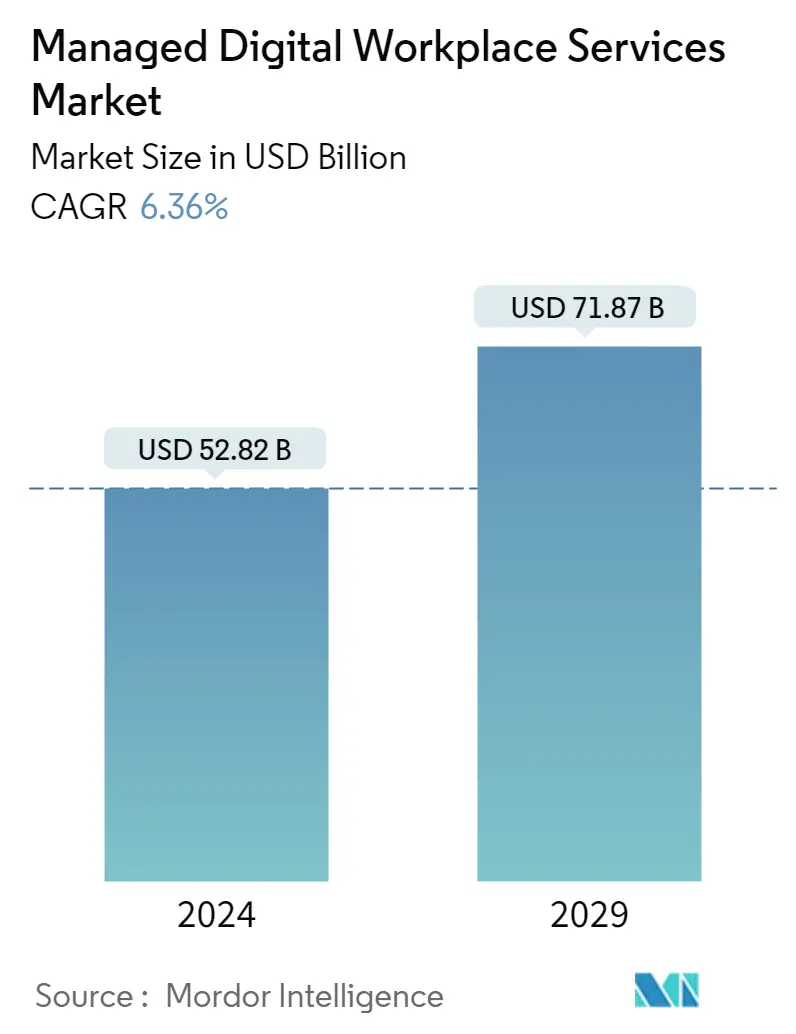Market Size of Managed Digital Workplace Services Industry

| Study Period | 2019 - 2029 |
| Market Size (2024) | USD 52.82 Billion |
| Market Size (2029) | USD 71.87 Billion |
| CAGR (2024 - 2029) | 6.36 % |
| Fastest Growing Market | Asia Pacific |
| Largest Market | North America |
| Market Concentration | Low |
Major Players
*Disclaimer: Major Players sorted in no particular order |
Managed Digital Workplace Services Market Analysis
The Managed Digital Workplace Services Market size is estimated at USD 52.82 billion in 2024, and is expected to reach USD 71.87 billion by 2029, growing at a CAGR of 6.36% during the forecast period (2024-2029).
The driving factors that can contribute to managed digital workplace services include technological advancements, changing workforce demographics, availability of new technologies and tools, employee demand for greater flexibility, and a positive company culture facilitated by strong and helpful management. Additionally, successful digital transformations are influenced by factors such as effective change management, employee engagement, and a clear understanding of the goals and objectives of the shift.
- The rise in adopting digital workplaces by various organizations would drive the demand for managed digital workplace services over the forecasted period. For instance, According to a survey done by beautiful.ai in 2022, which polled 3,000 managers to find out how the digital workplace has affected their businesses and what the future holds for the remote worker, 78% agree that significant financial resources are being directed toward achieving a successful digital workplace, and 80% said their firm is committed to investing financial resources in technology and tools to assist managers in successfully leading and meeting goals in a digital workplace. 81% are optimistic about digital work replacing their in-office setting. In a digital working environment, 66% feel that there is still a strong sense of connection.
- Furthermore, information technology has significantly impacted managed digital workplace services. With the increasing use of digital platforms and automation, workplaces have become more efficient and streamlined. Cloud-based facilities management software, for example, has enabled business leaders to stay organized and up-to-date, resulting in improved business performance. Additionally, digital workplace technologies have focused on communication, information management, and cybersecurity, providing better workflows and data management.
- Furthermore, artificial intelligence is increasingly important in managing digital workplace operations. By automating tasks and providing intelligent insights, AI enables organizations to streamline workflows, increase productivity, and improve employee experience. Some examples of AI applications in the digital workplace include knowledge management, data governance, information management, end-user experience management, and document management. Additionally, AI can help organizations formulate effective workplace automation strategies and increase employee productivity. As AI technology continues to evolve, it is expected to play an even more significant role in shaping the future of the digital workplace.
- Further, the changing technology and customer experience landscape in the BFSI sector will drive the demand for managed digital workplace services over the forecast period. Many BFSI sector companies, such as Swiss Re, an insurance firm, have partnered with market vendors to enable a cloud-based digital workplace, and the trend is expected to strengthen in the coming years, with the demand expected to increase from the BFSI sector. Further, the growing digital transformation in banks and insurance firms worldwide necessitates the need for digital workplace transformation for enhanced efficiency and productivity, thus further providing growth prospects for the studied market.
- For the global market for managed digital workplace services, the rising incidences of cybercrime present significant challenges and constraints. Securing digital assets, defending against cyber threats, and adhering to data protection regulations are challenging for organizations. Strong security measures and proactive security management are crucial in delivering managed digital workplace services due to the impact of cybercrime on customer trust and the requirement for greater investments in cybersecurity.
- Post-pandemic, hybrid work, and on-site work are gaining traction. Organizations worldwide must adapt to this new normal in different physical workplace settings or improvements in the corporate digital workplace. This work shift is analyzed to influence the demand for managed digital workplace services to improve work practices to ensure that productivity, operations, and business success continue. Post-pandemic, various firms have collaborated to use the benefits of the digital workplace; such a rise in collaborations would push the growth of the studied market during the pandemic.
Managed Digital Workplace Services Industry Segmentation
Managed digital workplace services provide an end-to-end approach to workflow processes through desktop delivery, mobility, service desk, collaboration, and user support while reducing operational IT costs. The study tracks the revenues generated from the services used in various end-user verticals across the globe. The income from the globally managed digital workplace services vendors and COVID-19's impact on market projection has also been considered.
The managed digital workplace services market is segmented by services (service desk, end-user device support, and digital workplace), end-user vertical (BFSI, healthcare, manufacturing, energy and utility, and government and public sector), and geography (North America, Europe, Asia-Pacific, and Rest of the world). The market sizes and forecasts are provided in terms of value in (USD) for all the segments.
| By Services | |
| Service Desk | |
| End-user Device Support | |
| Digital Workplace |
| By End-user Vertical | |
| BFSI | |
| Healthcare | |
| Manufacturing | |
| Energy and Utility | |
| Government and Public Sector | |
| Other End-user Verticals |
| By Geography | |
| North America | |
| Europe | |
| Asia-Pacific | |
| Rest of the World |
Managed Digital Workplace Services Market Size Summary
The Managed Digital Workplace Services market is poised for significant growth, driven by technological advancements and the evolving needs of the workforce. Organizations are increasingly adopting digital workplace solutions to enhance flexibility, productivity, and employee satisfaction. The integration of emerging technologies such as artificial intelligence and cloud-based tools is streamlining operations and improving communication and data management. Sectors like BFSI and healthcare are particularly keen on these services to boost efficiency and reduce costs, while the Asia-Pacific region is witnessing rapid digital transformation, further fueling market expansion. The demand for robust cybersecurity measures is also rising, as organizations seek to protect digital assets and maintain customer trust in an increasingly digital world.
The competitive landscape of the Managed Digital Workplace Services market is intense, with major players like Atos SE, Fujitsu Ltd, HCL, and Capgemini continuously enhancing their offerings. These companies are focusing on providing integrated services to meet the diverse needs of their clients. Strategic partnerships and collaborations, such as those between Stefanini and Phillip Morris International, and HCL Technologies and Intel, are enabling the development of tailored solutions that cater to specific market demands. The market's growth is further supported by investments in digital transformation initiatives across various sectors, highlighting the critical role of managed digital workplace services in shaping the future of work and operational efficiency.
Managed Digital Workplace Services Market Size - Table of Contents
-
1. MARKET INSIGHTS
-
1.1 Market Overview
-
1.2 Industry Attractiveness - Porter's Five Forces Analysis
-
1.2.1 Bargaining Power of Suppliers
-
1.2.2 Bargaining Power of Consumers
-
1.2.3 Threat of New Entrants
-
1.2.4 Threat of Substitutes
-
1.2.5 Intensity of Competitive Rivalry
-
-
1.3 Ecosystem Analysis
-
1.4 Impact of COVID-19 on the Market
-
-
2. MARKET SEGMENTATION
-
2.1 By Services
-
2.1.1 Service Desk
-
2.1.2 End-user Device Support
-
2.1.3 Digital Workplace
-
-
2.2 By End-user Vertical
-
2.2.1 BFSI
-
2.2.2 Healthcare
-
2.2.3 Manufacturing
-
2.2.4 Energy and Utility
-
2.2.5 Government and Public Sector
-
2.2.6 Other End-user Verticals
-
-
2.3 By Geography
-
2.3.1 North America
-
2.3.2 Europe
-
2.3.3 Asia-Pacific
-
2.3.4 Rest of the World
-
-
Managed Digital Workplace Services Market Size FAQs
How big is the Managed Digital Workplace Services Market?
The Managed Digital Workplace Services Market size is expected to reach USD 52.82 billion in 2024 and grow at a CAGR of 6.36% to reach USD 71.87 billion by 2029.
What is the current Managed Digital Workplace Services Market size?
In 2024, the Managed Digital Workplace Services Market size is expected to reach USD 52.82 billion.

